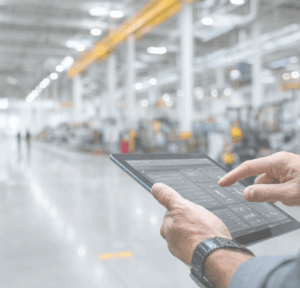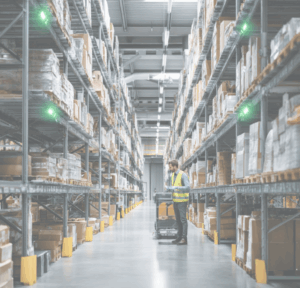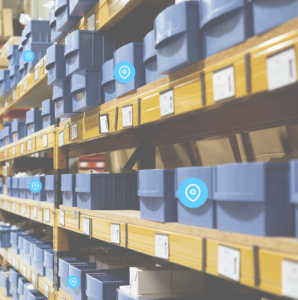Digital optimization in material flow: How eKanban makes processes more transparent and efficient.
In today’s industry, efficiency is key. Companies are constantly looking for innovative ways to optimize their production processes and improve material flow. But how can the entire production process truly become transparent and efficient? The answer may lie in a digital eKanban system that redefines the classic Kanban approach.
eKanban offers a smart solution for real-time material flow tracking and enables seamless integration into existing IT systems. This allows companies to not only optimize their processes but also eliminate waste and use resources more efficiently.
In this article, you’ll learn how eKanban works, the benefits it offers for industry, and how modern technologies like RTLS systems can further enhance efficiency.
The origins of Kanban: Efficiency from the automotive industry.
The Kanban method was developed in the late 1940s by the Japanese automobile manufacturer Toyota as an efficient work management method for manufacturing. The inspiration came from the replenishment system used by American discount retailers, where the amount of products to be restocked was aligned with actual sales figures—what was sold off the shelf was immediately replenished. Toyota applied this principle to its own production: instead of producing for inventory, only as much should be produced as was actually demanded.
Kanban is closely linked to the Just-in-Time method, which aims to provide materials and components exactly when they are needed in production. The goal: reduce waste and make production processes more efficient.
In the classic Kanban system, material flow is controlled through so-called Kanban cards. These cards contain the essential data for a production item, such as the required material type, quantity, and destination. Hence the name: the term “Kanban” comes from Japanese and means “document” or “signal card.” Once material is consumed, the card automatically signals the need for replenishment, ensuring that individual production processes are optimally coordinated.
How does the classic Kanban system work?
A Kanban system is based on a pull principle, where the replenishment of materials is triggered only when there is an actual demand. Typically, there are two containers for each type of material: While material is being taken from one container, the second one remains as a reserve. Once the first container is empty, the Kanban card is sent to the warehouse or supplier. This signals that new material needs to be provided.
Through this closed-loop system, the Kanban system ensures that the exact right amount of material is available at the right time – not too much and not too little. This helps avoid overproduction, long storage times, and unnecessary costs.
From the classic Kanban to digital eKanban
The classic Kanban system has proven itself over decades, helping companies make their production leaner and more efficient. However, with the increasing demands for flexibility, speed, and transparency in modern industrial processes, analog Kanban cards are reaching their limits. Physical cards can get lost, need to be manually updated, and do not provide real-time insights into the material flow.
This is where digital eKanban comes into play. By using modern technologies, the entire material flow is digitally captured, automated, controlled, and visualized in clear dashboards. Companies gain even more precise control over their production and logistics processes without interruptions in data flow or manual sources of error.
eKanban: This is how smart material flow works
eKanban is the digital evolution of the traditional Kanban system. While conventional Kanban processes rely on physical cards or container swaps, eKanban utilizes modern technologies such as IoT sensors to automate and manage material flow in real-time. This eliminates manual processes, providing companies with greater transparency and control over their production and logistics operations.
How does eKanban work?
The principle of eKanban stays true to the classic pull principle: materials are only reordered as needed. However, the control is no longer done via physical Kanban cards but through automatic digital signals. The process works as follows:
- Material consumption is recorded:
Sensors track in real-time when a material container is emptied or a specific threshold is reached. - Automatic reorder:
The system automatically sends a signal to the warehouse or supplier as soon as restocking is required. Through direct integration with ERP or MES systems, material management can be seamlessly incorporated into existing business processes. - Real-time monitoring and control:
Through a central eKanban dashboard, companies can view the current status of their material flow at any time. Bottlenecks, delays, or irregularities are detected early, allowing for faster response and intervention. - Automated supply:
The replenishment is delivered just-in-time, preventing overstocking and unnecessary storage costs. At the same time, it ensures that no production downtime occurs due to missing materials.
By combining automatic material tracking, digital reordering, and real-time transparency, eKanban not only optimizes material flow but also reduces manual errors, delays, and costs. It is a central solution for companies looking to make their production and logistics processes more efficient, flexible, and transparent.

Advantages of eKanban for Industry
In a modern production environment, every second counts – delays, bottlenecks, or unnecessary inventory not only waste time but also money. Production managers, logistics managers, and plant managers face the challenge of making their processes leaner, more transparent, and more efficient. This is where eKanban comes in, offering numerous advantages for the industry:
Real-time overview of inventory
With eKanban, uncertainties about material stocks are a thing of the past. Production managers have full transparency at all times regarding where materials are located and when replenishment is needed. This enables proactive planning and reduces unplanned downtime.
Automatic reordering reduces bottlenecks
Bottlenecks and overstock are two of the biggest challenges in production. eKanban solves this problem by automatically requesting a reorder as soon as a material stock falls below a defined threshold. This ensures that production continues smoothly without the need for manual reordering by staff.
Paperless & without manual errors
Classic Kanban systems are paper-based and prone to human errors. A missing or incorrectly filed card can bring the entire material flow to a standstill. eKanban completely eliminates this source of error: processes are digitized, information is always accessible, and interruptions in the data flow are a thing of the past. In this way, eKanban is a step towards paperless manufacturing for you.
Better planning & efficiency
Through the precise control of material flow, eKanban optimizes not only individual production processes but the entire supply chain. The digitization of these processes leads to better planning, reduces waiting times, and saves costs – whether through lower inventory levels, less search effort, or more efficient resource utilization.
Conclusion: Achieving Greater Efficiency and Transparency with eKanban
eKanban optimizes material flow in industry by automating processes, avoiding bottlenecks, and increasing real-time transparency. Companies that implement digital Kanban systems benefit from lower costs, better planning, and a smooth production process.
Partner solution: digital material flow control with ekko
Our partner ekko offers an innovative solution for eKanban. With their platform, they enable fully digitized and automated material flow control – without any manual scans or paper cards. Companies benefit from more efficient production and reduced storage costs. Find out more here: ekko eKanban.


